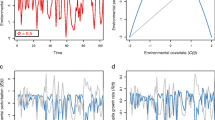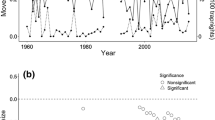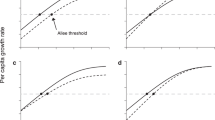Abstract
An important determinant of population dynamics is the degree of spatial covariance in demographic processes. Positive spatial covariance in demographic parameters and, consequently, spatial synchrony in population density dynamics develop whenever the spatial domain of determinants of demography exceeds the response scale of individual animals so as to synchronize demographic events such as births, deaths, and dispersal across space. Identifying the scale of spatial synchrony in density dynamics hints at which factors regulate populations and, thus, the characteristic scale of such regulating factors (Addicot et al. 1987, de Roos et al. 1991). In addition, estimating the strength of the synchrony is of interest because it may be a critical determinant of the stability and persistence of populations at various spatial scales (Hanski and Woiwod 1993).
Access this chapter
Tax calculation will be finalised at checkout
Purchases are for personal use only
Preview
Unable to display preview. Download preview PDF.
Similar content being viewed by others
Literature Cited
Aars, J., H. Andreassen, and R.A. Ims 1995. Root voles: litter sex ratio variation in fragmented habitats. Journal of Animal Ecology 64: 459–472.
Addicot, J.F., J.M. Aho, M.F. Antolin, D.K. Padilla, J.S. Richardson, and D.A. Soluk 1987. Ecological neighborhoods: scaling environmental patterns. Oikos 49: 340–346.
Andreassen, H.P., K. Hertzberg, and R. A. Ims. 1998. Space use repsonses to habitat fragmentation and connectivity in the root vole Microtus oeconomus. Ecology 79: 1223–1235.
Bjernstad, O.N., H.P. Andreassen, and R.A. Ims. 1998b. Effects of habitat patchiness and connectivity on the spatial ecology of the root vole Microtus oeconomus. Journal of Animal Ecology 67: 127–140.
Bjernstad, O.N., N.C. Stenseth, and T. Saitoh 1999. Synchrony and scaling in dynamics of voles and mice in northern Japan. Ecology: in press.
Boonstra, R., and C.J. Krebs. 1977. A fencing experiment on a high-density population ofMicrotus townsendii. Canadian Journal of Zoology 55: 1166–1175.
Charnov, E., and J.P. Finerty 1980. Vole population cycles. A case for kin-selection. Oecologia 45: 1–2.
Chesson, P.L. 1981. Models for spatially distributed populations: the effect of within-patch variability. American Naturalist 112: 127–154.
Collins, R.J., and G.W. Barrett 1997. Effects of habitat fragmentation on meadow vole (Microtus pennsylvanicus) population dynamics in experimental landscape patches. Landscape Ecology 12: 63–76.
de Roos, A.M., D. McCauley, and W.G. Wilson 1991. Mobility versus density-limited predator-prey dynamics on different spatial scales. Proceedings of the Royal Society London, Series B. 246: 117–122.
Diffendorfer, J.E., M.S. Gaines, and R.D. Holt. 1995. Habitat fragmentation and movements of three small mammals (Sigmodon, Microtus and Peromyscus). Ecology 76: 827–839.
Goodman, D. 1987. Considerations of stochastic demography in the design and management of reserves. Natural Resource Modeling 1: 205–234.
Hanski, I. 1994. Spatial scale, patchiness and population dynamics on land. Philosophical Transactions of the Royal Society London 343: 19–25.
Hanski, I., and I.P. Woiwod 1993. Spatial synchrony in the dynamics of moth and aphid populations. Journal of Animal Ecology 62: 656–668.
Hanski, I., and M.E. Gilpin 1997. Metapopulation dynamics: ecology, genetics and evolution. Academic Press, London, United Kingdom.
Harrison, S. 1991. Local extinction in a metapopulation context: an empirical evaluation. Biological Journal of the Linnean Society 42: 73–88.
Harrison, S., and J.F. Quinn 1989. Correlated environments and the persistence of metapopulations. Oikos 56: 2993–2998.
Haydon, D., and H. Steen 1997. The effects of large and small scale random events on the synchrony of metapopulation dynamics: a theoretical analysis. Proceedings of the Royal Society London, Series B. 264: 1375–1381.
Hurlbert, S.H. 1984. Pseudoreplication and design of ecological field experiments. Ecological Monographs 54: 187–211.
Ims, R.A. 1987. Male spacing systems in microtine rodents. American Naturalist 130: 475–484.
Ims, R.A. 1990. The ecology and evolution of reproductive synchrony. Trends in Ecology and Evolution 5: 135–140.
Ims, R.A. 1994. Litter sex ratio variation in colonies of two geographically distinct strains of the root vole Microtus oeconomus. Ecography 17: 141–146.
Ims, R.A. 1997 Geographic variation in reproduction and body growth rates in the root vole. Ecology 78: 461–470.
Ims, R.A., and N.C. Stenseth 1989. Divided the fruitflies fall. Nature 342: 21–22.
Ims, R.A., and H. Steen 1990. Regional synchrony of cyclic microtine populations: a theoretical evaluation of the role of nomadic predators. Oikos 57: 381–387.
Ims, R.A., S. Bondrup-Nielsen, and N.C. Stenseth 1988. The temporal pattern of breeding in small rodents. Oikos 53: 229–234.
Ims, R.A., J. Rolstad, and R Wegge 1993. Predicting space use responses to habitat fragmentation: can voles Microtus oeconomus serve as an experimental model system for Capercallie Grouse Tetrao urogallus in boreal forest? Biological Conservation 63: 261–268.
Ims, R.A., and N.G. Yoccoz 1997. Studying transfer processes in metapopulations: emigration, migration and colonization. Pages 247–265 in I. Hanski and M.E. Gilpin, editors. Metapopulation dynamics: ecology, genetics and evolution. Academic Press, London, United Kingdom.
Johannesen, E., H.P. Andreassen, and H. Steen 1997. Effect of radiocollars on survival of root voles. Journal of Mammalogy 78: 638–642.
Lambin, X., C.J. Krebs, and B. Scott 1992. Spacing system of the tundra vole Microtus oeconomus during the breeding season in Canada’s western Arctic. Canadian Journal of Zoology 70: 2068–2072.
Lambin, X., and N.G.Yoccoz 1998. The effect of population kin structure on nestling survival in Townsend’s vole, Microtus townsendii. Journal of Animal Ecology 67: 1–16.
La Polla, V.N., and G.W.Barrett. 1993. Effects of corridor width and presence on the population dynamics of the meadow vole (Microtus pennsylvanicus). Landscape Ecology 8: 25–37.
Machin-Rogalska, R., and L. Nabaglo 1990. Geographic variation in cyclic periodicity and synchrony in the common vole, Microtus arvalis. Oikos 59: 343–348.
Moran, P.A.P. 1953. The statistical analysis of the Canadian lynx cycle II. synchronization and meteorology. Australian Journal of Zoology 1: 291–298.
Myrberget, S. 1973. Geographical synchronisms of cycles of small rodents in Norway. Oikos 24: 220–224.
Paradis, E., Baillie, S.R., Sutherland, W.J., and R.J. Gregory. 1999. Dispersal and spatial scale affect synchrony in metapopulation dynamics. Ecology Letters (in press).
Pollard, E. 1991. Synchrony of population fluctuations: the dominant influence of widespread factors on local butterfly populations. Oikos 60: 7–10.
Ranta, E., V. Kaitala, J. Lindström, and H. Lindén 1995a. Synchrony in population dynamics. Proceedings of the Royal Society London, Series B. 262: 113–118.
Ranta, E., J. Lindström, and H. Lindén 1995b. Synchrony in tetranoid population dynamics. Journal of Animal Ecology 64: 767–776.
Santos, E.M. dos, H.P. Andreassen, and R.A. Ims. 1995. Differential inbreeding tolerance in two geographically distinct strains of root voles Microtus oeconomus. Ecography 18: 238–247.
SAS Institute Inc. 1992. SAS technical report. P-229. SAS Inst. Inc, Cary, North Carolina.
Steen, H., R.A. Ims, and G. Sonerud. 1996. Spatial and temporal patterns of small rodent population dynamics at a regional scale. Ecology 77: 2365–2372.
Stenseth, N.C., and R.A. Ims 1993. Population dynamics of lemmings: temporal and spatial variations. Pages 61–97 in N.C. Stenseth and R.A. Ims, editors. The biology of lemmings. Academic Press, London, United Kingdom.
Stenseth, N.C., O. Bjornstad, and W. Falck 1996. Is spacing behavior coupled with predation causing the microtine density cycle? A synthesis of current processes-oriented and pattern oriented-studies. Proceedings of the Royal Society of London B 263: 1423–1435.
Sutcliffe, O.L., C.D. Thomas, and D. Moss, 1996. Spatial synchrony and asynchrony in butterfly population dynamics. Journal of Animal Ecology 65: 85–95.
Tast, J. 1966. The root vole, Microtus oeconomus ( Pallas), as an inhabitant of seasonally flooded land. Annales Zoologici Fennici 3: 127–171.
Thomas, C.D. 1991. Spatial and temporal variablity in a butterfly population. Oecologia 87: 577–580.
Thomas, C.D., and I. Hanski 1997. Butterfly metapopulations. Pages 359–386 in I. Hanski and M.E. Gilpin, editors. Metapopulation dynamics: ecology, genetics and evolution. Academic Press, London, United Kingdom.
Ydenberg, R. 1987. Nomadic predators and geographical synchrony in microtine population cycles. Oikos 50: 270–272.
Viitala, J. 1994. Monogamy in free living Microtus oeconomus. Annales Zoologici Fennici 31: 343–345.
Wiens, J.A. 1989. Spatial scaling in ecology. Functional Ecology 3: 385–397.
Wiens, J.A., N.C. Stenseth, B. Van Horne, B., and R.A. Ims 1993. Ecological mechanisms and landscape ecology. Oikos 66: 369–380.
Wolff, J.O. 1993. Why are female small mammals territorial? Oikos 68:364–370.
Wolff, J.A. 1997. Population regulation in mammals. An evolutionary perspective. Journal of Animal Ecology 66: 1–13.
Editor information
Editors and Affiliations
Rights and permissions
Copyright information
© 1999 Springer Science+Business Media New York
About this chapter
Cite this chapter
Ims, R.A., Andreassen, H.P. (1999). Spatial Demographic Synchrony in Fragmented Populations. In: Barrett, G.W., Peles, J.D. (eds) Landscape Ecology of Small Mammals. Springer, New York, NY. https://doi.org/10.1007/978-0-387-21622-5_7
Download citation
DOI: https://doi.org/10.1007/978-0-387-21622-5_7
Publisher Name: Springer, New York, NY
Print ISBN: 978-1-4757-5640-1
Online ISBN: 978-0-387-21622-5
eBook Packages: Springer Book Archive




